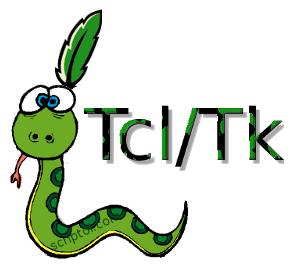Tcl, handheld and graphic scenarios
This language is used to create scripts and prototypes of programs. It can find Perl for web services in CGI . The language and graphics library are ported to almost all operating systems, so they can be used for portability quality.

Tcl, Tool Command Language (pronounce ticket) was created by John Usterhout in 1988. The Tk graphics library was available in 1991.
It is an interpreted, easily learned scripting language where each thing is a command and can be overridden. The syntax uses a number of characters, such as C, but is not a syntax of C. In C, each thing is an expression. He proposed a cycle of events long before JavaScript.
Although we can interact with its Tk graphics framework with all programming languages and especially C and Python (Tkinter), over time it lost interest without being updated to adapt to modern applications.
Tk does not have a declarative interface language such as QML (Qt), XAML, or even HTML 5, XML for Android, which seems mandatory these days, as Java shows by abandoning JavaFX Script, another procedural interface language such as Tk, in favor of JavaFX - declarative interface language
Tcl was supported by Sun for some time, which contributed to its development. Then Sun decided to devote itself to Java and the contents of the interpreter were transferred to an independent company - Script. Later it was resold, and the buyer had no interest in this language, he no longer had the development, on the contrary, of competing languages such as Python and Ruby. In addition, Tk, which was also showing interest, was overshadowed by GTK and Qt.
Tcl/Tk still has an active community, but has little future due to competition in new scripting languages like Go, and even JavaScript, which goes to the command line with Node.js. There is nothing in Tcl/Tk that cannot be done with Node, JavaScript and Canvas.
The Little language was designed to be compatible with Tcl code and its graphical set, while having a more readable C-like syntax.
Command language syntax and examples
An instruction is a command name (it is not a keyword) followed by a list of words separated by a space, arguments.
Statements end at the end of a line. It can be separated by semicolons on a single line.
Square brackets replace an argument with a command. Thus , they are substitute characters.
The = sign is never used, the "set " command assigns a value to the variable:
set nomvar valeur
Example:
set x 8
But before the name of the variable, you will need to add the $ character to refer to it (which is not in the tables):
puts $x
{} is used for non-subordinate grouping.
# enters a comment.
Control structures:
The if command uses two groups {}, the first for a condition, the second for actions.
if { $x < 10 } {
puts "x moins que 10"
}
The while command has the same syntax.
Procedures:
The definition begins with the proc command, followed by the name and two groups for arguments and statements .
proc nomproc { arguments } {
...instructions...
}
Code examples:
Show message:
puts "Salut le Monde!"
Show table contents:
array set maliste { d e m o }
foreach i [ array get maliste ] {
puts [ concat $i = maliste($i) ]
}
References: John C. Usterhout, Tcl and the Tk Toolkit, Addison-Wesley.
See the official Tcl/Tk (en) website.